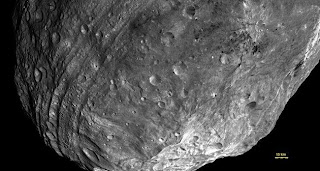 |
| Large Asteroid "Vesta" |
It is relevant because that extinction was not caused by Darwin's concept of Natural Selection ("species extinction is caused by not being fit to survive"), no, it was caused by an abiotic event wholly unrelated to biological evolution.
While the ink was still wet, as they say, this morning in Russia a meteoroid became a meteor then parts of it became meteorites when they impacted the ground in Russia.
There are some videos below of the event, and the scary sounds it produced.
The meteorite we spoke of yesterday, Chicxulub, was gargantuan compared to the one that affected Russia this morning.
Chicxulub caused a 120 mile wide crater, 1,000 foot tidal waves, and wiped out most of the species then existing on the Earth.
Today, let's consider the controversial issue of whether or not the Russian meteorite was in anyway linked to or associated with the bigger Asteroid 2012 DA14 which will pass within about 17,200 miles of the Earth in several hours.
Was it a satellite, debris "near" that asteroid, a left-over from an impact that asteroid had with other space rocks or asteroids, or totally unrelated?
In previous episodes (e.g. Weekend Rebel Science Excursion - 7) we have considered the ideas of the rebel astronomer who worked at the Naval Observatory.
Being a scientist, he knew that any hypothesis had to jump through some hoops prior to being able to play with the big boys, and that one such hoop is to make predictions based on the hypothesis.
So, he predicted that asteroids and comets would have satellites or moons like the Earth and other planets have.
Here is how that worked out for him:
The hypothesis of the explosion of a number of planets and moons of our solar system during its 4.6-billion-year history is in excellent accord with all known observational constraints, even without adjustable parameters. Many of its boldest predictions have been fulfilled. In most instances, these predictions were judged highly unlikely by the several standard models the eph would replace. And in several cases, the entire model was at risk to be falsified if the prediction failed. The successful predictions include: (1) satellites of asteroids; (2) satellites of comets; (3) salt water in meteorites; (4) “roll marks” leading to boulders on asteroids; (5) the time and peak rate of the 1999 Leonid meteor storm; (6) explosion signatures for asteroids; (7) strongly spiked energy parameter for new comets; (8) distribution of black material on slowly rotating airless bodies; (9) splitting velocities of comets; (10) Mars is a former moon of an exploded planet.(EPH 2000, emphasis added). The way this impacts the current and growing practice of astronomers, who watch for Near Earth Objects (NEO), is clear.
They should also consider that some of these asteroids will have satellites which, like the object that hit Russia today, injuring hundreds, should be considered along with the asteroids they orbit.
Already scientists commenting on the event say both "yes this meteorite could be related to Asteroid 2012 DA14", and "no it could not be related."
How would we tell?
One way would be to use the gravitational formulas and see if Asteroid 2012 DA14 has enough mass so as to have sufficient gravity to hold today's Russian meteorite captive as a satellite.
Let's keep it simple by using Newton's reasoning and formula: "F = G m1 m2/r2", where "G" is the universal constant for gravity.
One could derive the value of "F" for the Earth and Moon, compare with those figures "F" to Asteroid 2012 DA14 and the object that hit Russia, and see if there is reason to calculate further, or reason to conclude from that result.
At the moment there isn't enough data to know accurately enough the size and mass of the object that hit Russia, so maybe next week we can do the math.
The next post in this series is here, the previous post in this series is here.
No comments:
Post a Comment